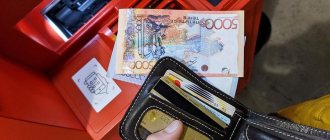Article 159.3 of the Criminal Code of the Russian Federation – Fraud using electronic means of payment
Fraud using electronic means of payment means the theft of someone else's property using someone else's (fake) bank card (credit, debit, etc.) by deceiving an employee of a credit, banking, trade and other organization.
Electronic means of payment (in accordance with Federal Law dated June 27, 2011 No. 161-FZ “On the National Payment System”) - a means or method that allows a client of a money transfer operator to draw up, certify and transmit orders for the purpose of transferring funds within the framework of applicable forms of non-cash payments using information and communication technologies, electronic storage media, including payment cards, as well as other technical devices.
Punishment for committing fraud with payment cards (Article 159.3 of the Criminal Code of the Russian Federation)
Punishment for committing this crime includes both a fine and long-term imprisonment.
For example, for committing fraudulent actions with payment cards as part of an organized group or causing damage in the amount of over 6,000,000 rubles, the punishment includes imprisonment for up to 10 years with a fine of 1,000,000 rubles.
The minimum punishment for committing card fraud involves a fine of up to 120,000 rubles.
If fraud is committed by a person using a counterfeit payment card, then this act will be classified as a set of crimes (Article 327 of the Criminal Code of the Russian Federation and Article 159.3 of the Criminal Code of the Russian Federation).
Forensic characteristics of lending fraud
You need to know your opponent by sight, therefore, to study a specific act, methods of committing it, methods of combating and investigating, you must first study its forensic characteristics, standard methods of committing it, and common mechanisms used to carry out theft. Then, when developing an investigation plan, it will be possible to work in already known areas.
For all types of acts provided for in Articles 159, 159.1–159.6 of the Criminal Code of the Russian Federation, the method of fraud will be deception or abuse of trust of the person who makes the decision to issue funds or who owns them. But in fact, it is not the banks themselves who become victims of credit fraud, but their depositors, the people who entrusted them with their funds. This is due to the fact that deposits of individuals, ordinary workers or pensioners usually become credit resources. If a bank that systematically issues non-repayable loans collapses, they will be the first to suffer.
For Article 159.1 of the Criminal Code of the Russian Federation, such persons will be bank employees or managers who are provided with false or unreliable documents or information. Falsity in this case is characterized as a deliberate forgery, therefore sometimes such an act is considered in conjunction with articles providing for liability for the use of forged documents. But a sign of unreliability when applying forensic characteristics of this composition may simply mean insufficient data, which is why the credit officer cannot make the right decision when considering them, or accurately assess the borrower’s solvency.
Among the data falsification techniques most often used by legal entities are:
- providing not a real balance sheet, but with changed indicators that should prove a sufficiently stable financial condition of the company;
- provision of a collateral whose characteristics do not correspond to those stated: dilapidated property complexes, non-working machines or equipment;
- providing documents for collateral that do not belong to the borrower or do not actually exist;
- falsification of business plans and other documents, promises of inflated revenues for a credited business project.
It is not always possible for a specific bank employee to independently identify counterfeit or unreliable information. This has to be done by the bodies of inquiry and investigation when conducting an investigation, using typical forensic characteristics of the act.
Sometimes, in the event of fraud by individuals, security services guard the interests of the bank and are able to identify, for example, signs of a fake passport: a re-taped photograph, a difference between the data on the place of issue of the passport and those indicated on the seal, information about the cancellation of the passport in the Ministry of Internal Affairs database. Such crimes are easier to investigate than those committed in the field of business activity. Already at the stage of identifying a forgery, it is possible to initiate a criminal case of attempted crime under Art. 159.1 of the Criminal Code of the Russian Federation. It is considered completed when funds are credited to the criminal’s accounts or payment is made for the goods he purchased, if the fraud is committed in the field of consumer lending. But even for an attempt to commit it, a criminal caught red-handed can be held accountable.
An important forensic characteristic of the act provided for in Art. 159.1 of the Criminal Code of the Russian Federation, it is committed as part of a group of persons, one of the participants of which is a bank employee. Their connivance often helps to commit crimes, and the investigator, studying a specific case, will definitely check the bank employee who prepared the documents, his possible connection with the criminal who directly issued the loan, and the alleged organizer. In the case of applying for a loan to a legal entity specially created and used for the purpose of theft, you can contact the organizer by establishing which economic group this legal entity belongs to. This can be done by analyzing possible signs of affiliation.
When analyzing the method of committing a crime, it can be established that it will be a set of interconnected steps and actions of one or more persons. The purpose of the act will always be to obtain a loan, commercial or targeted, the interest on which is subsidized by public funds. Such subsidization of part of the interest rate sometimes constitutes a separate crime, ordinary fraud. This happens in cases where a loan provided under state support is spent inappropriately. The investigation of such acts is often complicated by the interest of regional authorities and managers of local bank branches. Any crime in the commission of which the management of a banking institution is involved or it itself becomes the organizer is usually distinguished by the most serious qualifying criteria that fall under the influence of the norms of Part 4 of Art. 159.1: committing a crime in the field of lending with the participation of an organized group or causing damage on an especially large scale.
Defense in criminal cases of fraud using electronic means of payment
Work on a criminal case initiated on the grounds of a crime under Article 159.3 of the Criminal Code of the Russian Federation has a number of specific features.
So, to qualify the committed act under Art. 159.3 of the Criminal Code of the Russian Federation, the preliminary investigation or inquiry authorities must prove the fact of intent to steal funds from a bank card before they are directly received.
In addition, the commission of this crime is possible only in the commodity-monetary sphere, for the purpose of purchasing goods or services, including on the Internet, or withdrawing cash.
If you are accused of committing a crime under Article 159.3 of the Criminal Code of the Russian Federation, you should immediately contact a lawyer for economic crimes, since even at the stage of verification carried out by the operational unit, it is possible to solve the problem that has arisen.
Defense by a lawyer of an accused of committing fraudulent actions in payment cards consists of providing the necessary legal assistance, expressed in the analysis of the evidence base available to the investigation, developing a position on the case and work strategy, identifying inadmissible evidence, legal assistance in exercising the full scope of rights available to the client , especially at the time of interrogation, search, identification or confrontation, etc.
Investigation methodology
At the first stage of the investigation, investigators adhere to the standard algorithm:
- determine the main directions in which the investigation will be conducted;
- appoint urgent primary operational and investigative actions (search, seizure of documents, interviewing witnesses);
- establish important circumstances relevant to the case;
- perform the range of procedural actions established by law;
- establish the facts that must be proven during the investigation, the limits of the investigation.
All decisions of the investigator must be based on the full scope of information that can be obtained at the very beginning of the investigation. At the same time, inspection of the scene of the incident, search and other steps related to the presence of the investigative team on the territory of the bank must be carried out promptly so as not to disrupt the usual operating hours of the credit institution. If any evidence must be seized and there are securities among them, they must be described in as much detail as possible and provided with such a storage regime that their loss becomes impossible. Other investigative actions must also be carried out with the utmost care.
Information obtained in the first hours of the investigation becomes the basis for the formation of a further set of investigative actions. Sources of information when committing a crime in the field of lending are:
- information obtained during an inspection of the premises of the malicious borrower;
- acts of inventory and audits;
- information obtained during inspection of equipment or warehouses in which goods that were pledged were stored;
- audit reports;
- written explanations from employees of the borrower organization or persons affiliated with it;
- consultations with specialists in a particular area of business activity.
All of these sources may contain both reliable and false information, and their evaluation must be approached with the utmost caution. Information of forensic significance should be classified in a separate group. The investigator will have to prove the fictitiousness of the business activity, the presence of intent to commit a crime, and the fact of conspiracy of a group of persons. The following points may indicate this:
- lack of assets that should be present based on balance sheets or inventory reports;
- presence of documents or seals of different legal entities in the same room;
- documents for the production of seals;
- presence of double-entry bookkeeping;
- availability of data on possible falsification of business plans and documents on the basis of which the loan was received, information about them does not coincide with those that can be requested from the tax office;
- sending inquiries to the Federal Tax Service about the actual financial position of the borrower, its financial statements, and payment of taxes;
- facts of frequent presence on the borrower's territory of bank employees who could be involved in a crime.
One of the important forensic characteristics of an act is the determination of the personal characteristics of the subject of the crime, which help narrow the circle of suspects. When carrying out the first investigative actions, you can establish:
- whether the subject is connected with the criminal world - fake, stolen passports or pasted photographs indicate this;
- how involved he is in entrepreneurial activity - this is evidenced by the quality of preparation of business plans and other documents;
- what field of activity does he specialize in?
For the court, it becomes very important to establish the motive for the crime, and for this composition it is not in every case exclusively mercenary. Often additional motives are the selfishness of banks, numerous cases of people being deprived of apartments and other property, leading to suicide. This position helps the subject justify his actions. It is curious that among the subjects of such crimes, 76% are men, 24% are women, and they more often act as accomplices. 74% of all crimes in the lending sector are committed with accomplices. Interestingly, the average age of scammers is about 40 years. This is partly explained by the fact that in order to mislead a bank specialist, you need to have an already established social status.
After establishing the identity of the organizer of the fraudulent scheme, the investigator needs to determine a preventive measure for him, and this is where the difficulties begin. A special feature of a criminal subject is his high mobility: thanks to previously stolen amounts, he can leave the country at any time. Often, the first signal that an investigation is underway leads to the immediate withdrawal of company funds under the pretext of payment of payments, purchase of agricultural products, or other legally permitted purposes for legal entities to obtain cash. As a rule, in this situation, the company’s accountant becomes an accomplice, whose written testimony will help prove the presence of intent to commit a crime in the field of lending. In criminal cases of this kind, it is often financial workers who become defendants; the organizers and general directors cannot be found, and it is not always possible to prove the involvement of a bank employee in fraud. The criminal activity, however, stops, but it is not possible to return the money to the credit institution or government agency. That is why the immediate actions of the investigator to identify the organizer of the scheme and detain him and place him under arrest help partially compensate for the damage caused. But this is not always possible. The state policy of decriminalizing crimes committed in the sphere of business activity, in which judges avoid using measures such as pre-trial detention, often makes it difficult to stop a fraudster. He is helped by experienced lawyers and the opportunity to offer a significant amount of money as collateral.
Sometimes concealing the fact of a crime falling under Article 159.1 “Fraud in the field of lending” is carried out through bankruptcy. In this case, it is extremely difficult to prove that the loan was taken with the original purpose of not repaying it. In bankruptcy cases, many new creditors appear - from employees with wage debts to tax authorities, the culprit actively defends himself, allegedly trying to save the enterprise, but in vain. Such false bankrupts usually, bypassing the stage of financial recovery and supervision, immediately order bankruptcy proceedings, during which the accomplices receive all the company’s property for next to nothing.







